Dollar spot off and racing; Irrigation = Ascochyta blight; Seedheads draining lawn health; Mind mowing decks and blades to reduce clipping issues.
Weather
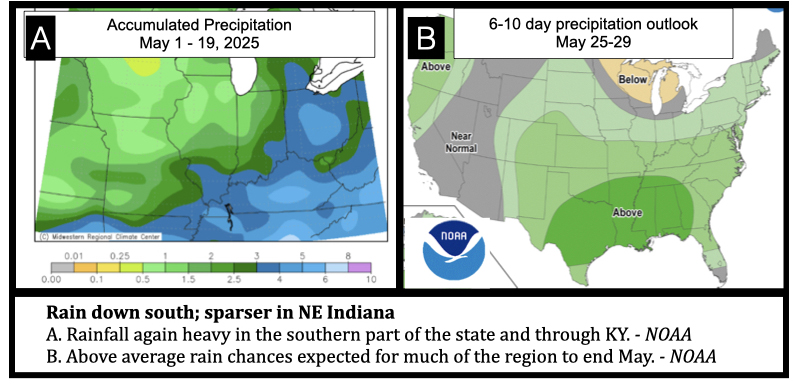
In April 2025, Indiana as a whole had the 30th warmest temperature and 10th most precipitation on record over 131 years of weather data. Indianapolis was 2.5 F above average, and the 3rd wettest on record with 8.02 inches of rainfall to follow up last year’s 6th wettest April (7.77 inches). Indy averages 4.34 inches of rain in April, so we’ve gotten our fair share of both April warmth and showers to fuel May flowers in 2024 and 2025. This pales in comparison, however, to our southern neighbors. Evansville and much of Kentucky finished with 21+inches of rain in April (top 10 on record for much of the region)! Conversely, the northeast portion of Indiana can use more precipitation, showing that we are on the dividing line between the have nots and have too much.
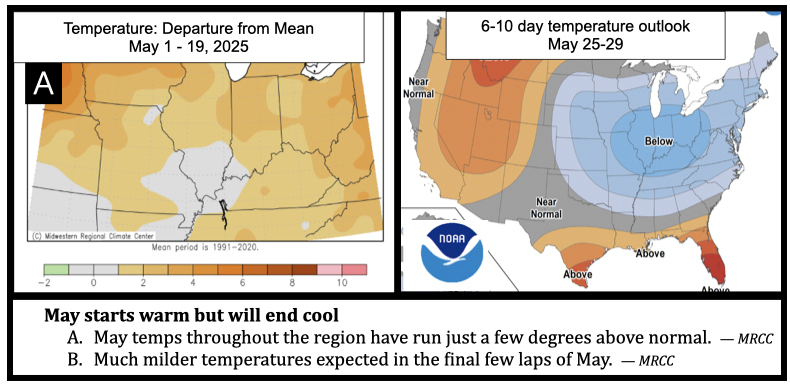
With the approach of Carb Day, temperatures are expected to remain very mild in the final laps of May. Temperatures over the last 30 days in the region have run 3-5 degrees above normal, and this break should be advantageous for turfgrass growth before the doldrums of summer stress hit.
Golf – Dollar Spot Racing on Bentgrass in mid-May
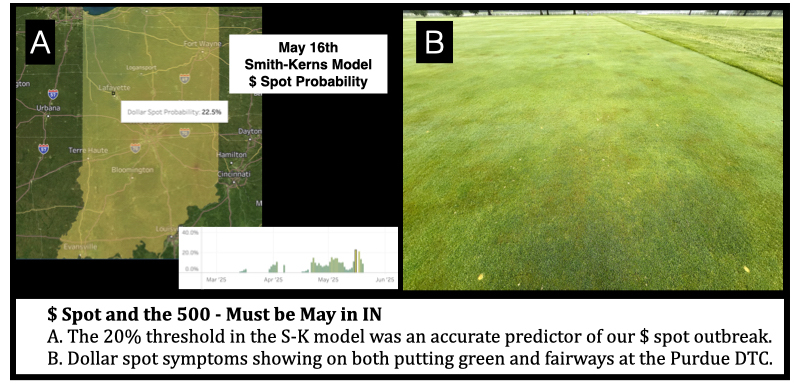
The first outbreaks of dollar spot hit the gas and were noticed last Friday at the research farm. Fairway symptoms were first noticed Friday and summarily noted again on Monday. Impressively, the Smith-Kerns dollar spot model nailed this first outbreak again with calculated probabilities > 20% on May 16-18, which corresponded perfectly to our first outbreak. As a research site with a long history of dollar spot research, the Daniel Center has quite the buildup of inoculum (artificially introduced and natural) and our fertility levels are quite low. All of our outbreaks are on known susceptible bentgrass cultivars and annual bluegrass.
Recent studies demonstrate differences in needed dollar spot control with newer resistant bentgrass varieties. Hempfling et al reported higher Smith Kerns model probabilities (above 20%) could be used with resistant (or less susceptible) cultivars in timing preventive fungicide applications. Zhang et al found that reacting to dollar spot outbreaks on resistant varieties with curative applications greatly reduced the overall fungicide inputs needed over the course of the season and lowered the risk of severe disease outbreaks.
If you have an older cultivar (particularly on greens), preventive applications may be necessary. If you haven’t made this application yet, now is the time. Our recent research indicates preventive applications of mefentrifluconazole, pydiflumetofen and fluxapyroxad may provide noticeable reductions (but not zero) in dollar spot severity through the season, especially if watered in to also target soilborne diseases on putting greens.
Wet Spring Irrigation = Ascochyta Blight on Lawns
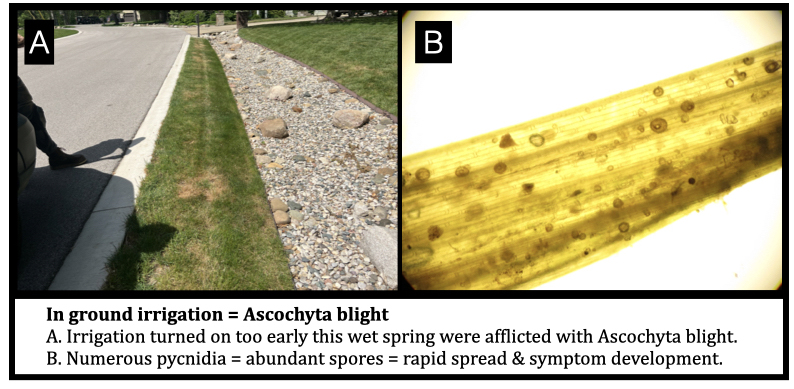
A rash of Ascochyta blight outbreaks on tall fescue and Kentucky bluegrass lawns in Indianapolis and the Lafayette area occurred in early May. Foliar decline spread along mower tracks and was segregated to various areas of the lawn. One of the lawn care operators noted the outbreaks all occurred along one particular route, which makes sense since this disease is caused by a pathogen that sporulates profusely and could easily be carried on water or debris lodged in a mower from one site to the next. All of these lawns also had their in-ground irrigation turned on by a typical late April schedule and running. As noted above, rainfall has been more than adequate in April and May and this increased leaf wetness from irrigation likely spurred the epidemic further. Somewhat frustratingly, lower maintained and non-irrigated lawns right next to those affected are often left unharmed.
The good news is Ascochyta blight is solely foliar, and when the leaves get dry for a minute and temperatures warm, the disease normally fades and the lawn recovers. Very little if any information is available regarding fungicide control and use is not recommended. Obviously, turning off irrigation is a necessary first step. Moderate fertilization (see below) is not known to spur the disease. Importantly, identify these diseased lawns and mow them last in the day. The leaf blades on these lawns will hopefully be drier later in the day and this reduces the likelihood of moving the disease to a new property.
Excessive Clippings and Seedheads Impact Lawn Health
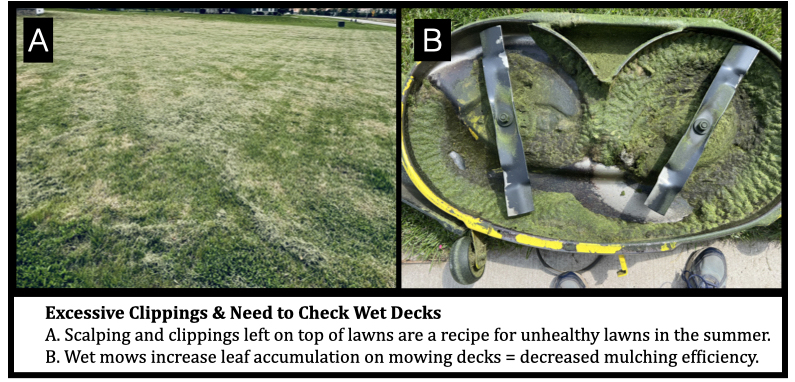
We’ve received some reports of thinning or sickly looking lawns in the last two weeks. Symptoms don’t appear disease related and no pathogens are apparent in the scope. These lawns are likely being afflicted by one or both of the following common spring issues.
Clippings – Noted in the last report, excessive clippings have been observed left after mowing on many lawns. This is a common occurrence in wet springs like this one, since scheduling mowing events at the frequency needed to keep up with growth is darn near impossible. Also, most of are depending on mulching decks to reduce or eliminate clippings; a great idea to return some nutrition and organic matter back into a normally substandard home lawn soil. However, when mowing wet leaves, they tend to accumulate in the deck and reduce or eliminate the needed the mulching effect.
Seedheads – As part of their natural life cycle, cool season grasses are seeding heavily now. Kentucky bluegrass and tall fescue will seed in the spring with the idea of spreading themselves and allowing for germination in open areas (same thing the weeds are doing). This process, however, comes at a fitness cost which can sometimes lead to more rapid leaf senescence. Remember that a turfgrass leaf typically is formed and dies in 30-45 days (also a natural process). These seedhead stalks are often coarser and more difficult to mow, which can also result in a rougher, or even rustic, look to a lawn.
For both of these issues, pay attention to fertility and mowing. Waiting until seeding or just after for an initial or second spring fertilization can help boost turfgrass past the fitness cost caused by seedhead formation. Of course, fertilization will lead to more growth and therefore maintaining mowing frequency will be necessary. Second, make sure to inspect and clean the mowing deck at the end of the day. Acccumulation of clippings on the deck will restrict the mulching power of the blades and leave behind more cut leaves. Third, make sure the mow blades are not dull, which won’t give the mulching option a chance. Last but not least, break out the blower after every mow and walk the lawn, dispersing as many clumps of clippings as possible. If big clumps are left, rain pounds them down into a patty, and the result will nearly always be a disappointing bare spot in the lawn.
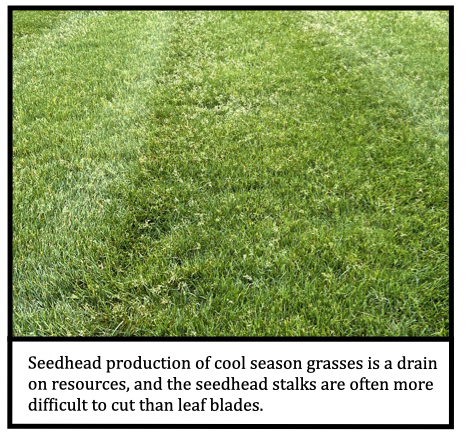
The Departure of Matt Carpenter
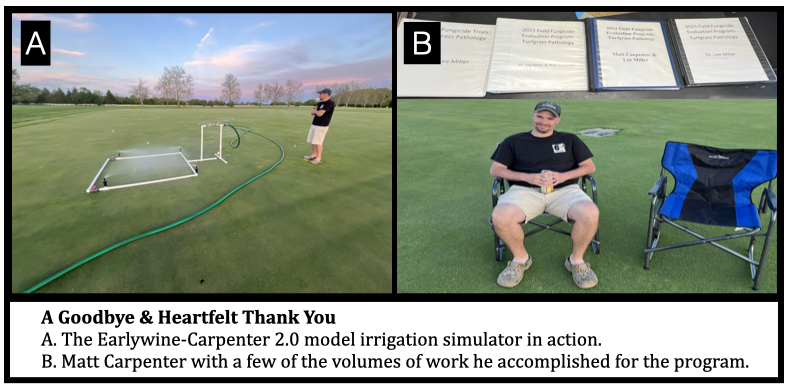
Our main compatriot, Matt Carpenter is leaving the program to head back to his home state of Tennessee. Matt has been our research technician and director of the field research program since I arrived at Purdue, and has been instrumental in the success of the Purdue turfgrass pathology program since he got here in 2022. His dedication and can-do attitude have been treasured assets, and I’ve been blessed in my career to have worked with him and my previous technician at Mizzou, Daniel Earlywine. As a final lasting hurrah, the three of us just published an expansive study conducted at both Missouri and Purdue assessing dollar spot efficacy of 18 different fungicides after watering them in to target soilborne diseases.
Thank you for all of your considerable efforts and accomplishments Matt, and know you have been crucial factor to the success of our program. I appreciate you. Best of fortunes and see you again soon my friend.
SAVE THE DATE: Purdue Turfgrass and Landscape Field Day – Tuesday, July 8th
Extension Turfgrass Pathologist – Purdue University
Follow on Twitter: @purdueturfpath